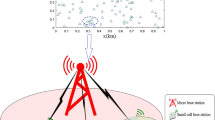Abstract
Design of energy and spectrum-efficient multi-tier small cell network is an emerging research area. This paper has addressed the challenges of power optimization and interference mitigation in small cell based multi-tier network. We propose a macro–pico–femtocell and micro–pico–femtocell based leader–follower network, referred as leader follower based multi-tier cellular network, where picocells and femtocells form groups inside the macrocell and microcell. The picocell serves as leader and femtocells as followers in each pico–femtocell group. Frequency allocation for this network is also proposed. Simulation results demonstrate that the proposed network has up to 3.58% less power consumption than the macro–pico–femtocell network. Simulation results also illustrate that using the proposed multi-tier network the signal-to-interference-plus-noise ratio for femtocell user is improved by 53.9–60.64% and 23.18–28.16% approximately than the macro–femtocell network and micro–femtocell network respectively.



Similar content being viewed by others
References
Andrews, J. G., Zhang, X., Durgin, G. D., & Gupta, A. K. (2016). Are we approaching the fundamental limits of wireless network densification? IEEE Communications Magazine,54(10), 184–190.
Bhushan, N., Li, J., Malladi, D., Gilmore, R., Brenner, D., Damnjanovic, A., et al. (2014). Network densification: the dominant theme for wireless evolution into 5G. IEEE Communications Magazine,52(2), 82–89.
Deb, P., Mukherjee, A., & De, D. (2018). A study of densification management using energy efficient femto-cloud based 5G mobile network. Wireless Personal Communications,101(4), 2173–2191.
Wang, W., & Shen, G. (2010). Energy efficiency of heterogeneous cellular network. In 2010 IEEE 72nd vehicular technology conference (pp. 1–5). IEEE.
Mukherjee, A., Bhattacherjee, S., Pal, S., & De, D. (2013). Femtocell based green power consumption methods for mobile network. Computer Networks,57(1), 162–178.
Razavi, R., & Claussen, H. (2012). Urban small cell deployments: Impact on the network energy consumption. In 2012 IEEE wireless communications and networking conference workshops (WCNCW) (pp. 47–52). IEEE.
Prasad, A., Tirkkonen, O., Lundén, P., Yilmaz, O. N., Dalsgaard, L., & Wijting, C. (2013). Energy-efficient inter-frequency small cell discovery techniques for LTE-advanced heterogeneous network deployments. IEEE Communications Magazine,51(5), 72–81.
Liu, C., Natarajan, B., & Xia, H. (2016). Small cell base station sleep strategies for energy efficiency. IEEE Transactions on Vehicular Technology,65(3), 1652–1661.
Cai, S., Che, Y., Duan, L., Wang, J., Zhou, S., & Zhang, R. (2016). Green 5G heterogeneous networks through dynamic small-cell operation. IEEE Journal on Selected Areas in Communications,34(5), 1103–1115.
Chung, Y. L. (2015). An energy-saving small-cell zooming scheme for two-tier hybrid cellular networks. In 2015 international conference on information networking (ICOIN) (pp. 148–152). IEEE.
Mukherjee, A., Deb, P., & De, D. (2017). Small cell zooming based green congestion control in mobile network. CSI Transactions on ICT,5(1), 35–43.
Mukherjee, A., & De, D. (2018). Octopus algorithm for wireless personal communications. Wireless Personal Communications,101(1), 531–565.
Ghosh, S., De, D., Deb, P., & Mukherjee, A. (2018). 5G-ZOOM-Game: Small cell zooming using weighted majority cooperative game for energy efficient 5G mobile network. Wireless Networks. https://doi.org/10.1007/s11276-018-1818-9.
Mukherjee, A., De, D., & Deb, P. (2018). Power consumption model of sector breathing based congestion control in mobile network. Digital Communications and Networks,4(3), 217–233.
Ge, X., Yang, J., Gharavi, H., & Sun, Y. (2017). Energy efficiency challenges of 5G small cell networks. IEEE Communications Magazine,55(5), 184–191.
Zhang, H., Huang, S., Jiang, C., Long, K., Leung, V. C., & Poor, H. V. (2017). Energy efficient user association and power allocation in millimeter-wave-based ultra dense networks with energy harvesting base stations. IEEE Journal on Selected Areas in Communications,35(9), 1936–1947.
Mukherjee, A., De, D., & Deb, P. (2016). Interference management in macro–femtocell and micro–femtocell cluster-based long-term evaluation-advanced green mobile network. IET Communications,10(5), 468–478.
Xu, P., Fang, X., Chen, M., & Xu, Y. (2013). A Stackelberg game-based spectrum allocation scheme in macro/femtocell hierarchical networks. Computer Communications,36(14), 1552–1558.
Zhu, K., Hossain, E., & Anpalagan, A. (2015). Downlink power control in two-tier cellular OFDMA networks under uncertainties: A robust Stackelberg game. IEEE Transactions on Communications,63(2), 520–535.
Hamouda, S., Zitoun, M., & Tabbane, S. (2014). Win–win relationship between macrocell and femtocells for spectrum sharing in LTE-A. IET Communications,8(7), 1109–1116.
Kang, X., Zhang, R., & Motani, M. (2012). Price-based resource allocation for spectrum-sharing femtocell networks: A stackelberg game approach. IEEE Journal on Selected Areas in Communications,30(3), 538–549.
Mukherjee, A., Deb, P., De, D., & Obaidat, M. S. (2019). WmA-MiFN: A weighted majority and auction game based green ultra-dense micro–femtocell network system. IEEE Systems Journal. https://doi.org/10.1109/JSYST.2019.2911977.
Acknowledgements
Department of Science and Technology (DST) for SR/FST/ETI-296/2011.
Author information
Authors and Affiliations
Corresponding author
Additional information
Publisher's Note
Springer Nature remains neutral with regard to jurisdictional claims in published maps and institutional affiliations.
Rights and permissions
About this article
Cite this article
Mukherjee, A., Deb, P. & De, D. LFMTCN: A Green Ultra-Dense Multi-tier Small Cell Network Using Leader–follower Strategy. Wireless Pers Commun 110, 275–289 (2020). https://doi.org/10.1007/s11277-019-06726-y
Published:
Issue Date:
DOI: https://doi.org/10.1007/s11277-019-06726-y




